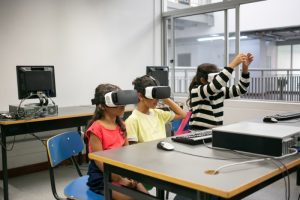Artificial intelligence (AI) is making its way into classrooms around the world.
Teachers are finding creative ways to utilize AI tools such as intelligent tutoring systems, automated grading software, and adaptive learning platforms to enhance learning, provide personalized instruction, gauge student comprehension in real-time, and make their jobs a little easier.
From AI tutors to plagiarism checkers, these innovations are shaping the future of education by allowing more individualized attention and feedback for each student.
Go to Page Section:
Automated Grading and Feedback
One of the most time-consuming tasks for teachers is grading assignments and tests.
AI-powered software can automate the grading process and provide students with instant feedback.
Systems like Gradescope allow teachers to upload assignments and use machine learning to score multiple-choice, numeric, and coding questions.
The software even captures handwritten work using photo recognition.
Essay grading tools like the best AI checker for teachers can analyze written responses for grammar, spelling, and style.
This allows teachers to focus less on rote grading and more on providing qualitative feedback.
Some programs like Turnitin even detect plagiarism by comparing student work against billions of web pages and academic databases.
Personalized Tutors
AI tutoring systems are becoming popular for drilling academic skills in math, reading, and writing.
Many of these tutors, like Pearson’s TutorAI, use speech recognition and natural language processing to understand where students are struggling.
The tutors then target the skills each student needs to practice the most.
Some AI tutoring platforms can even mimic human conversation using chatbots.
This makes the experience more engaging for students and enables tutors to serve more learners simultaneously.
Studies show one-on-one human tutoring is one of the most effective teaching methods, and AI is making this level of personalization more accessible.
Virtual Assistants
Teachers have to juggle enormous responsibilities that can take away time from lesson planning and student interactions.
AI virtual assistants like GeekBuddy lend them a helping hand by taking attendance, organizing files, emailing parents, scheduling meetings, grading assignments, tracking student progress, and handling other time-intensive administrative tasks.
By automating these functions, teachers save precious time that can be reallocated to direct instruction, one-on-one tutoring, and relationship-building with students to advance their success further.
Classroom Management
Keeping students focused and well-behaved is critical for learning but takes up a lot of mental energy.
AI classroom management tools use speech recognition and machine vision to help.
Sensors track noise levels in the classroom while software monitors student engagement.
The systems alert teachers when interventions may be needed, like when chatter rises or students appear distracted.
Some experimental systems even claim to identify emotions like joy, sadness, anger, and confusion using facial analysis algorithms.
While this branch of AI is still being perfected, such systems could give teachers insight into social dynamics that impact learning.
Adaptive Learning Software
One major benefit of AI is its ability to continually adjust based on data and feedback.
Several education technology companies are using adaptive algorithms to personalize learning.
Platforms like Dreambox dynamically adapt math lessons to build on concepts students have mastered and re-teach abilities they struggle with.
Other programs identify knowledge gaps using short diagnostic quizzes.
They then assign customized materials to fill those gaps.
While computer-based adaptive learning already exists, AI takes it further by considering performance, engagement, motivation, and learning habits.
This level of personalization was previously unheard of in education.
The Future of AI in the Classroom
AI is certainly not a silver bullet in education, but it holds exciting potential.
Automating routine tasks allows teachers to focus on mentoring and inspiring students.
AI tutors make one-on-one support more achievable, while adaptive software customizes education like never before.
However, schools must be judicious in adopting this technology.
AI should complement human teachers, not replace them.
The social and emotional connections teachers build are irreplicable and essential for childhood development.
Finding the right balance will lead to AI tools that enhance learning and create positive school experiences.
The age of artificial intelligence has arrived in schools.
Teachers are seizing opportunities to elevate education through creative applications of AI.
Moving forward thoughtfully, this technological revolution could make quality instruction more accessible and effective.
Though it may not receive an A+ yet, classroom AI has made the honor roll and shows tremendous promise if appropriately utilized by teachers.










